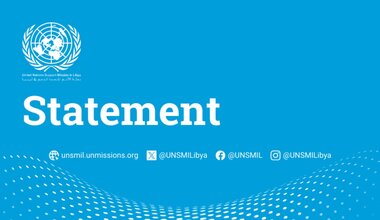Human Rights Report on Civilian Casualties - March 2017
Tunis – From 1 March to 31 March 2017, the United Nations Support Mission in Libya (UNSMIL) documented 24 civilian casualties - 20 deaths and 4 injuries - during the conduct of hostilities across Libya. Victims included 9 men killed and 3 injured, 6 women killed and 1 injured, and 3 children killed. The gender of two killed adult civilians is unknown.
Civilian Casualties
The majority of civilian casualties were caused by gunfire (11 deaths, 2 injured). Other causes were airstrikes (4 deaths, 1 injured) and shelling (3 deaths). Two civilians were killed when a military plane crashed. One civilian was injured as a result of an Explosive Remnant of War (ERW).
UNSMIL documented 8 deaths and 2 injuries in Benghazi, 5 deaths in Tripoli, 3 deaths in Ras Lanouf, 1 death and 1 injury in al-Zawiya, 2 deaths in Tobruk, 1 death in Sabha, and 1 injury in Nofliya. All victims were Libyan, with the exception of a Nigerian man killed in crossfire between armed groups in Sabha.
The civilian casualties included a 14-year-old girl and two other civilians killed on 14 March as a result of
indiscriminate fire during clashes between armed groups in Tripoli. There were further civilian casualties from the Ganfouda neighbourhood of Benghazi, including a woman who died in airstrikes on 6 March. On 18 March, 7 civilians (4 women, 2 children and 1 elderly man) were killed and 1 woman injured as they were fleeing Block 12 in Ganfouda, controlled by the Benghazi Revolutionaries Shura Council (BRSC) and surrounded by the Libyan National Army (LNA).
The month of March also witnessed attacks on banks in Tripoli. On 8 March, a man was fatally wounded in the vicinity of the al-Aman Bank. On 28 March, a security guard at the National Commercial Bank was shot dead.
Civilian Facilities
On 4 March, the Ras Lanouf Medical Centre was hit in airstrikes, which resulted in the deaths of two male ambulance drivers and another man accompanying a patient. The airstrikes caused some material damage and the destruction of two ambulances parked outside. The Medical Centre reopened on 26 March once repairs were completed.
On 14 March, the al-Khadhra Hospital in Tripoli was hit twice by indiscriminate fire, causing damage to the maternity ward and Intensive Care Unit (ICU).
Attribution
While no one claimed responsibility for the airstrikes, information gathered indicated that the LNA and allies carried out the airstrikes that caused civilian casualties and damage to civilian objects in Benghazi, Nofliya and Ras Lanouf. UNSMIL was unable to determine with certainty which parties to the conflict caused the other civilian casualties in March.
Other Casualties
On 7 March, at least 13 bodies of Sub-Saharan Africans were uncovered in the Telil forest near Sabrattah. The circumstances of their deaths remain unclear, amid reports that some of the deceased bore gunshot wounds.
On 22 March, a 12-year-old Sudanese boy was injured in the shoulder in the Ard Zwawa neighbourhood of Benghazi. The circumstances of the shooting are unclear, but there were no clashes in the area at the time.
In the context of armed clashes in Ganfouda in March, two videos emerged depicting LNA fighters carrying-out summary executions of 4 captured fighters apparently with the BRSC. In one video, a LNA fighter is seen shooting dead three men as they kneel facing a wall with their hands tied behind their backs. In the second video, a group of fighters are seen insulting, beating and chasing a captured and unarmed man before opening fire at him. On 20 March, the LNA’s General Command announced investigations into criminal acts and reiterated the LNA’s commitment to applicable national and international law.
On 25 March, 54 unidentified bodies, reportedly some recovered from Ganfouda, were buried after DNA samples were taken. The Libyan Red Crescent reported finding 6 bodies in a mass grave. The LNA claimed these were bodies of their fighters.
During March, UNSMIL also documented the fatal shootings of 1 man and 1 boy in al-Zawiya and of another man in Tripoli in unclear circumstances.
Note
The figures for civilian casualties set out above only include persons killed or injured in the course of hostilities and who were not directly participating in the hostilities. The figures do not include those casualties that are not a direct result of hostilities, for example executions after capture, torture or abductions, or casualties caused as an indirect consequence of hostilities. The figures are based on information UNSMIL has gathered and cross-checked from a broad range of sources in Libya, including human rights defenders, civil society, current and former officials, employees of local governments, community leaders and members, witnesses, others directly affected and media reports. In order to assess the credibility of information obtained, where possible, UNSMIL reviewed documentary information, including medical records, forensic reports and photographic evidence.
The figures are only those that UNSMIL was able to document in the reporting period. They are not likely to be complete and may change as new information emerges about incidents involving civilian casualties that took place during this period.
Similarly, while UNSMIL has systematically tried to ensure that the cases it documented are based on credible information, further verification would be required to attain a higher standard of proof. Due to the security situation, UNSMIL has not been able to carry out direct site visits in Libya to obtain information. Disruption in communications especially in areas controlled by groups pledging allegiance to ISIL and fear of reprisals against sources further hamper information gathering.
While not all actions leading to civilian casualties breach international humanitarian law, UNSMIL reminds all parties to the conflict that they are under an obligation to target only military objectives. Direct attacks on civilians as well as indiscriminate attacks – which do not distinguish between civilians and fighters – are prohibited. Attacks that are expected to cause incidental loss of civilian life, injury to civilians and damage to civilian objects excessive to the anticipated concrete and direct military advantage are also prohibited. Such attacks amount to war crimes that can be prosecuted by the International Criminal Court.
In order to ensure greater protection of the civilian population and essential infrastructure, all parties engaged in fighting in Libya must cease the use of mortars and other indirect weapons and imprecise aerial bombardments in civilian-populated areas, and not place fighters or other military objectives in populated areas. All executions of captives must cease and all those captured including fighters must be treated humanely in all circumstances. Murdering or torturing captives is also a war crime, regardless of what the captive may be accused of.
 United Nations Peacekeeping
United Nations Peacekeeping UN
UN









